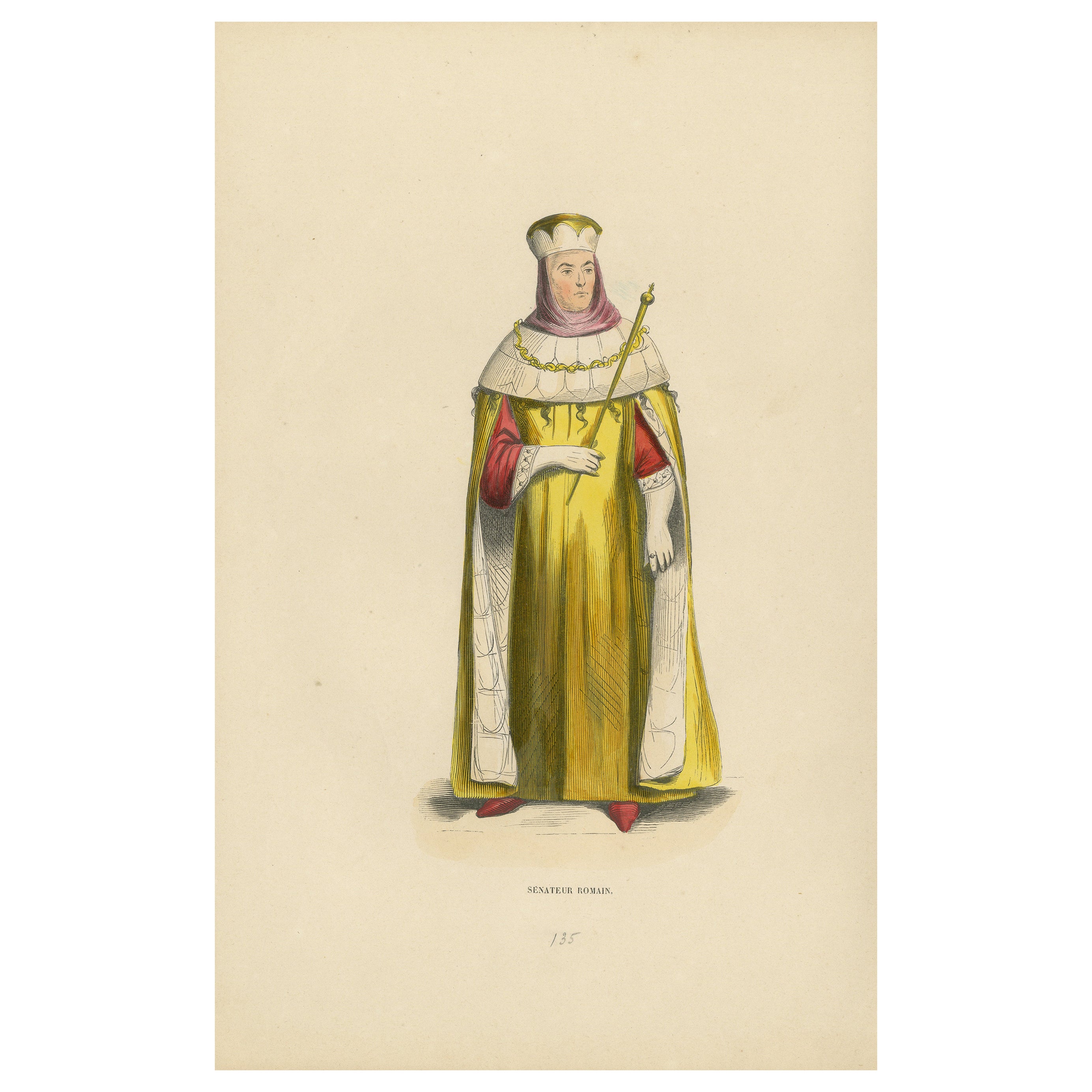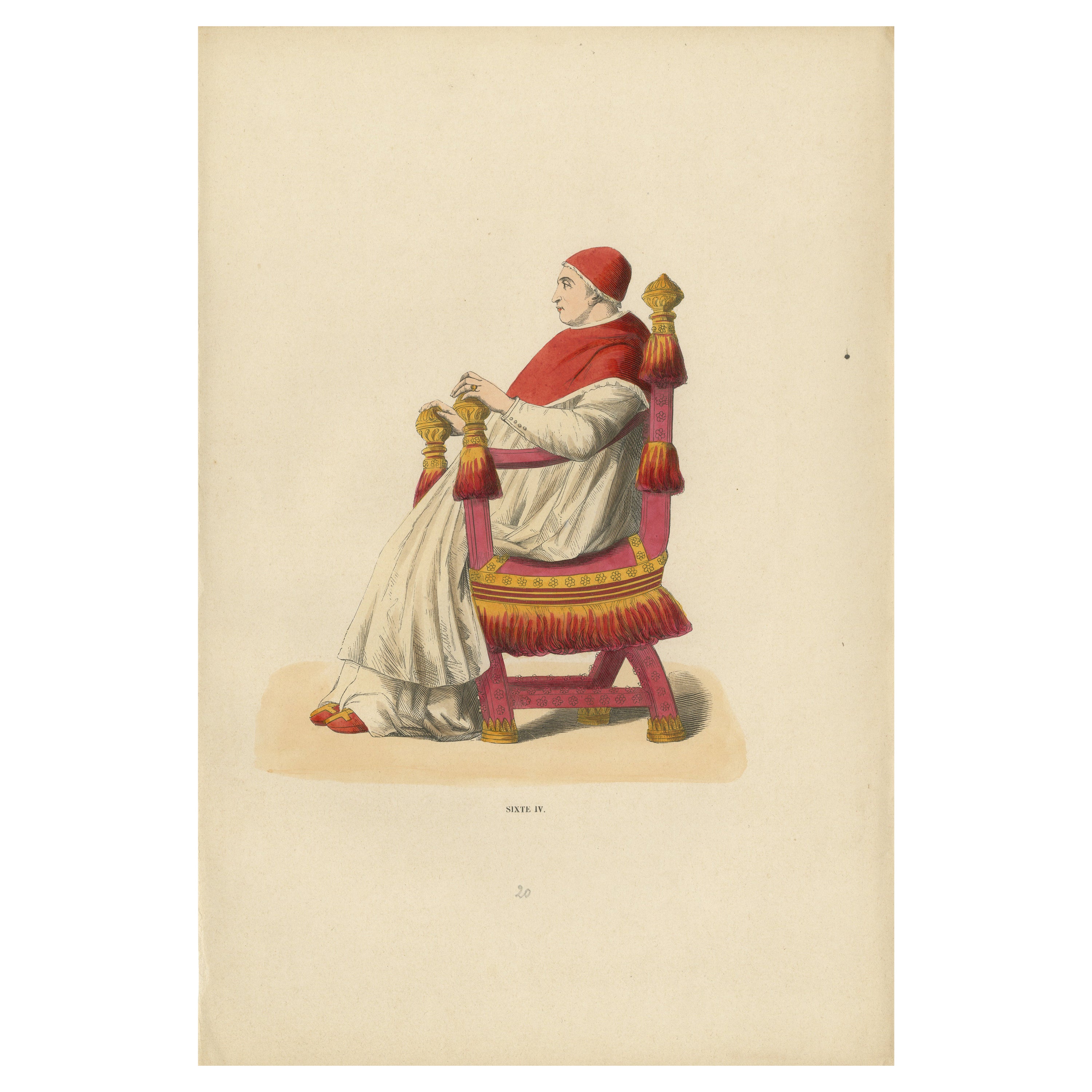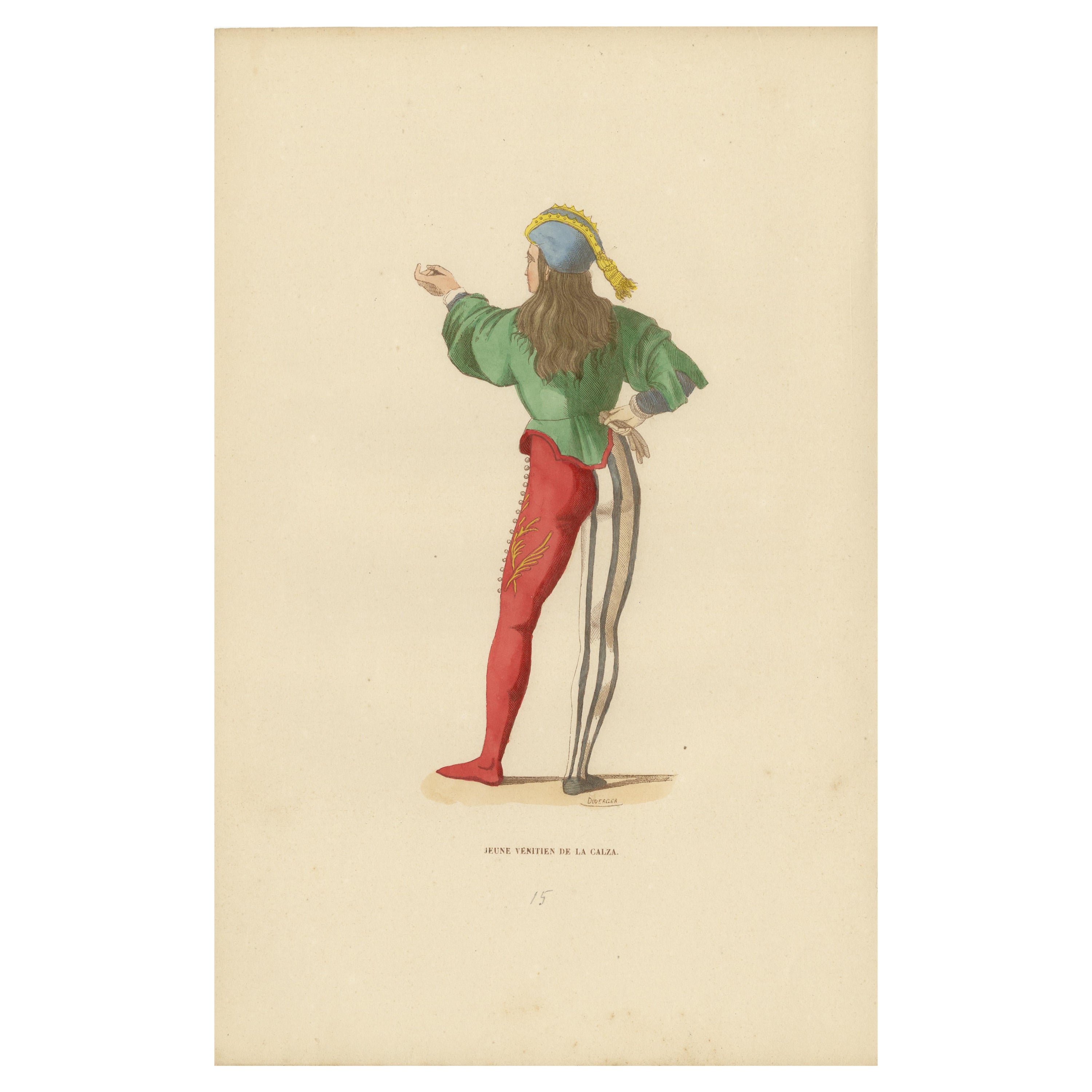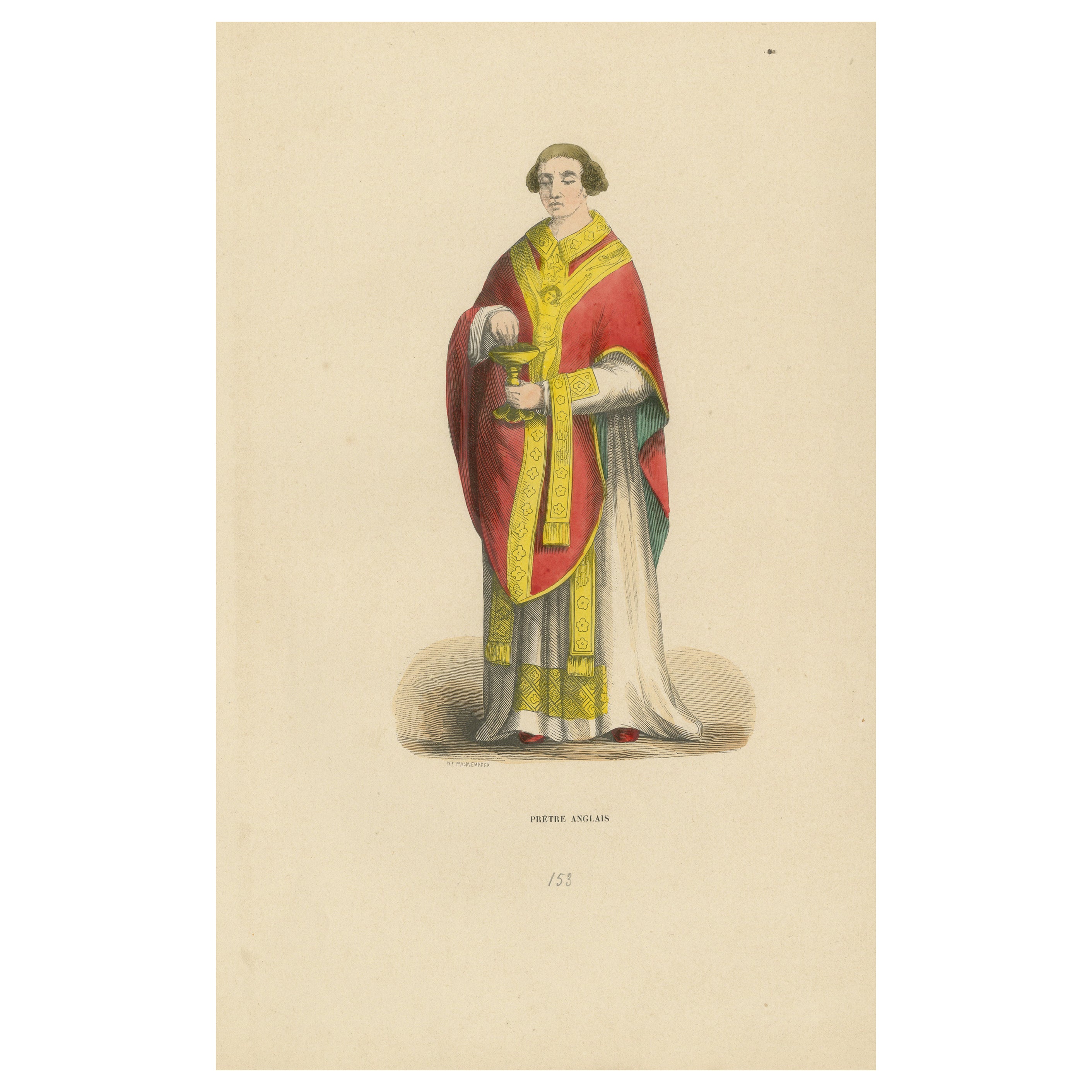Items Similar to Venetian Dignity: The Doge in Contemplation, Engraving of 1847
Want more images or videos?
Request additional images or videos from the seller
1 of 6
Venetian Dignity: The Doge in Contemplation, Engraving of 1847
About the Item
Title: "Venetian Dignity: The Doge in Contemplation"
Description: This handcolored historical print captures a Doge of Venice in a moment of solemn reflection. The Doge, as the chief magistrate and leader of the Republic of Venice, was a figure of significant authority and respect. His attire, rich in color and decoration, is befitting his high office.
He stands draped in a luxurious robe of deep red, symbolizing power and prestige, edged with detailed trim that speaks to the wealth of the Venetian state. His undergarment is a contrasting blue, perhaps alluding to the maritime dominance of Venice, while the green sash may represent growth and prosperity. His footwear, adorned with golden motifs, complements the ornamental hem of his cloak.
The Doge's cap, or corno ducale, is a distinctive feature, signifying his ruling status, with its elaborate design and regal embellishments. His beard, a sign of wisdom and maturity, frames his contemplative expression as his hand rests over his heart, a gesture that may denote his dedication and service to the city.
This portrayal not only serves as a historical record of the regalia and personage of a Doge but also evokes the gravity and introspection fitting for a leader of one of the most powerful maritime republics of the Renaissance era. It's a frozen narrative, one that allows us to infer the weight of responsibility borne by the Doges who helped shape Venice's storied past.
The colors have a nice glow over them. Historically, egg whites, known as glair, and sometimes egg yolk were indeed used in illumination and painting, particularly in manuscripts, to give colors a brighter appearance and to add a sheen or gloss to the work. This technique was quite common during the Middle Ages and into the Renaissance.
Egg whites can be applied as a varnish over pigments to enhance their brightness and to protect the colors. This application could make the colors appear more vivid and also add a slight glossy sheen to the surface of the image.
Egg yolk, on the other hand, was commonly used as a binding agent in paint. It forms the basis of tempera paint, a medium that was widely used before the advent of oil painting. Egg yolk helps to create a durable and long-lasting color that adheres well to various surfaces.
In the context of the print from 1847, it's less likely that egg whites or yolks were used directly on the print, as by that time, commercial printing processes would have been more advanced and less reliant on such manual methods. However, if this print is a representation of an earlier style or is meant to mimic the appearance of hand-painted manuscripts, the original artists might have employed techniques or materials that gave a similar effect to those achieved with egg-based binders and varnishes.
- Dimensions:Height: 10.63 in (27 cm)Width: 7.09 in (18 cm)Depth: 0 in (0.02 mm)
- Materials and Techniques:
- Period:
- Date of Manufacture:1847
- Condition:Good. Overal light toning and light soiling but the image itself clean and hand-colored almost 200 years ago and still in expliciet colors. Aged paper with typically warm, yellowish-brown hue, mostly around the edges. Study the images carefully.
- Seller Location:Langweer, NL
- Reference Number:
About the Seller
5.0
Platinum Seller
These expertly vetted sellers are 1stDibs' most experienced sellers and are rated highest by our customers.
Established in 2009
1stDibs seller since 2017
1,919 sales on 1stDibs
Typical response time: <1 hour
- ShippingRetrieving quote...Ships From: Langweer, Netherlands
- Return PolicyA return for this item may be initiated within 14 days of delivery.
More From This SellerView All
- Imperial Dignity: A Roman Senator's Garb, Lithograph Published in 1847Located in Langweer, NLTitle: "Imperial Dignity: A Roman Senator's Garb in 'Costume du Moyen Âge'" Description: This lithograph, part of the 1847 "Costume du Moyen Âge" collection, depicts a Roman senator...Category
Antique 1840s Prints
MaterialsPaper
- In Sacred Contemplation: Pope Sixtus IV on the Papal Throne, 1847Located in Langweer, NLThe image for sale depicts a figure labeled "Sixte IV," which refers to Pope Sixtus IV, who was the head of the Catholic Church from 1471 to 1484. He is portrayed seated in an ornate...Category
Antique 1840s Prints
MaterialsPaper
- Engraving of a Guardian of the Fort: The Medieval Arbaletrier, 1847Located in Langweer, NLThe image is labeled "Arbaletrier," which is French for crossbowman. It depicts a medieval soldier equipped for battle. The crossbowman is dressed in a pink tunic with a blue collar...Category
Antique 1840s Prints
MaterialsPaper
- Youthful Extravagance: A Member of the Venetian Calza, 1847Located in Langweer, NLThis original antique print depicts a person labeled as "Jeune Vénitien de la Calza," which translates to "Young Venetian of the Calza." The Calza was a Renaissance cultural associat...Category
Antique 1840s Prints
MaterialsPaper
- In Solemn Duty: A Canon in Contemplation, Hand-Colored Lithograph, 1847Located in Langweer, NLThe image portrays a figure labeled "Chanoine," which is French for "Canon," referring to a clergy member who is part of a cathedral or a collegiate chapter. The individual is depicted in ecclesiastical robes that reflect his status within the church hierarchy. The canon is shown wearing a long, pink robe with a decorative stole over it, which is adorned with Christian symbols and patterns indicating his religious office. Over the robe, he wears a black mozzetta, a short cape that is typically worn by higher clergy in the Roman Catholic Church. He also has a white almuce, a fur-trimmed hood or shoulder cape worn by canons, draped over his left arm, and he is holding what appears to be a book of scripture or liturgy. His head is adorned with a biretta, a square cap with three or four peaks...Category
Antique 1840s Prints
MaterialsPaper
- Clerical Dignity: An English Priest in 'Costume du Moyen Âge', 1847Located in Langweer, NLTitle: "Clerical Dignity: An English Priest in 'Costume du Moyen Âge'" Description: This lithograph, part of the "Costume du Moyen Âge" series from 1847, depicts an English priest a...Category
Antique 1840s Prints
MaterialsPaper
You May Also Like
- Group of Nine Framed Colored Engravings of Venetian PalazzosLocated in Essex, MAEach beautifully framed and each illustrating Venetian palazzos with titles. Each in a creme painted and gilded and carved frame.Category
Antique 18th Century Italian Prints
MaterialsWood, Paper
- Hand-Colored Engraving of the Ceiling of the Church of Santa Costanza in FrameLocated in Pembroke, MAA large, nicely-framed Italian hand-colored engraving in tones of terracotta and black (17th century, with more recent matte and frame) by Pietro Bartoli. The engraving depicts the mosaic ceiling in the church of Santa Costanza outside of Rome, which was studied by the ecclesiatical archaeologist Giovanni Ciampini. The mosaic ceiling no longer exists, but is known through various depictions of the artwork, such as this engraving. The images include Christian imagery including the sacrifice of Cain and Abel and possibly Noah building the ark. The upper row of mosaics is believed to represent scenes from the New Testament, with caryatids dividing the ceiling into twelve segments. The engraving is captioned in Latin: "Opus Musiuum olim in tholo Templi, quod vulgo creditur Bacchi, nunc Sancte Constantie extra Portam Piam cariatides, et Telamones in duodecium dividant Segmenta, ubi plura autumnales ferias, et piscationis Genium demostrant, iuxta interpretionem Ciampini qui mediatatem exhibet Veterum monum." In the 17th century, the church of Santa Costanza was known as the "Temple of Bacchus," and was the site of rowdy Bacchic festivals until Pope Clement XI banned the rites in 1720. Pietro Santo...Category
Antique 17th Century Italian Baroque Prints
MaterialsPaper, Paint, Wood, Ink
- Original Piranesi Framed Engraving of a Monument in the Form of a CornucopiaBy Giovanni Battista PiranesiLocated in San Francisco, CAGiovanni Battista Piranesi, Italian 1720-1778) Engraving on wove paper depicting an ancient Roman funeral monument in the form of a cornucopia from the Via...Category
Antique Early 19th Century French Neoclassical Prints
MaterialsPaper
- 19C Engraving of Lake Gaube in the Pyrenees by T AllomBy Thomas AllomLocated in Dallas, TXPresenting a lovely 19C engraving of Lake Gaube in the Pyrenees by T Allom. From circa 1850. Besautiful depiction of Lake Gaube or Lac de Gaube in the F...Category
Antique Mid-19th Century French Victorian Prints
MaterialsPaper
- Charles Monnet " National Assembly In The Night Of August 4-5 " EngravingLocated in Beuzevillette, FRThis engraving represents the National Assembly in the night of August 4 and 5, 1789 realized by Isodore Stanislas Herman after the work of Charles Monnet...Category
Antique Late 18th Century French Picture Frames
MaterialsPaper
- 19th Century French Engraving in Giltwood Frame, 'The Fishermen of the Adriatic'Located in Dallas, TXEntitled Les Pecheurs de L’Adriatique (“The Fishermen of the Adriatic”), this 19th-century engraving is after the original 1834/1835 painting by Léopold Robert. The print is encased ...Category
Antique 19th Century French Prints
MaterialsWood, Giltwood, Paper





